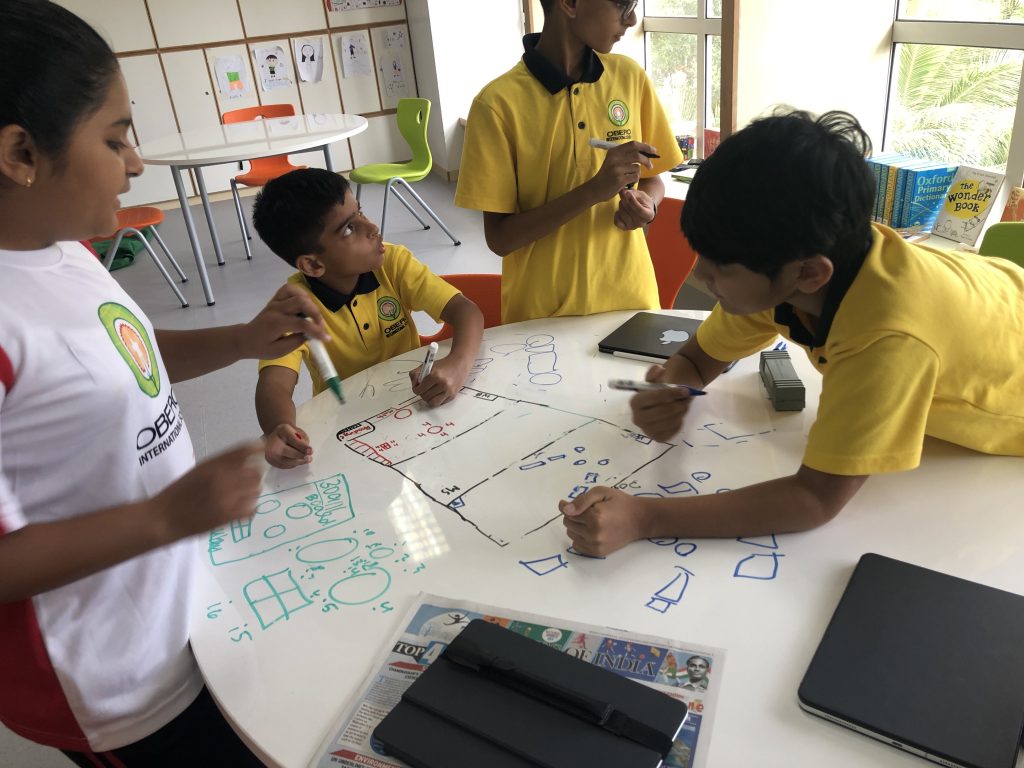Teacher Hemal Panchal, at Oberoi International School, in India, explains how a student-led classroom makeover enhanced their learning.

What started as a unit of inquiry into ‘Sharing the planet’, became a meaningful classroom redesign challenge for 38 Primary Years Programme (PYP) students at Oberoi International School, in India. As students talked about how they share the planet, a discussion about how we can share our learning spaces better followed. Students then decided a classroom redesign was necessary to enhance their learning experiences.
The planning
Students began by assessing their current learning spaces and what facilities they already had. Then, they made a list of things they wanted to add, using the “must-haves” and an “amazing” (ideal-things-to-have) criteria.
To create safe, stimulating and inviting learning spaces, students wanted to include areas for audio recording; solving challenging mathematics problems; expression through art; a recycling bin; a reading corner; a games section; group collaboration areas; and a space to create displays that reflect their learning process.

Thinking of the possible layouts that would support their redesign was the second step. A class discussion was led by students. They moved around furniture and talked through all the layout suggestions. They also formed small groups to test out their ideas and brainstorm and came to a number of conclusions. One student said: “It is important to have the unit of inquiry elements posted in multiple spaces because we constantly refer to it.”
“It will be amazing to have quotes on the walls because it will motivate us when we are feeling low,” another student said.
Students also decided that our classroom ‘Essential Agreements’ shouldn’t be placed all together, but should be displayed wherever a particular agreement is applicable. For example, ‘We will respect our resources’, should be placed where resources are kept. We also decided to create a ‘celebration corner’, which would include artwork, actions, photos and achievements.
At the time, our literacy writing unit was ‘Persuasive writing’. Using their newfound persuasive skills, students asked parents if they could bring items from home to decorate their spaces, such as fairy lights for the reading corner, decorative bedsheets to craft tents, recyclable items to make stationery boxes, and games.
Students were happy with the outcome. They worked together to design and enhance their learning spaces, which everyone could benefit from. Students demonstrated action-oriented problem solving, creativity and teamwork.
Reflection
Reflection is an integral part of learning. Students were asked to share three things they learned; two things they found interesting; one thing they wish to have, which will help their learning; and what their next steps were. Responses included learning how to effectively work with others, and ways to adapt to the new spaces.
Teacher reflection is equally important. I learned how students can take ownership of their learning spaces, by choosing where they want to learn, and how this results in a smoother flow to the classroom. I also discovered that students who are emotionally invested stay more engaged in their learning, and this task promoted high levels of independence, encouraging children to access different learning materials.

Designing and creating learning spaces can be led as an inquiry. My advice to teachers, who want to also complete a similar task with their class is:
- Reduce your input
- Always ask students for their input and ideas: traditional classrooms are not in line with modern learning so remove what is no longer required in the classroom
- Create spaces for collaboration: all spaces are open to learning so use hallways too
- Create spaces for creativity and always reflect.
Flexible learning spaces should encourage a balance of experiences to facilitate Approaches to Learning (ATL), and promote choice, decision-making and independence.
